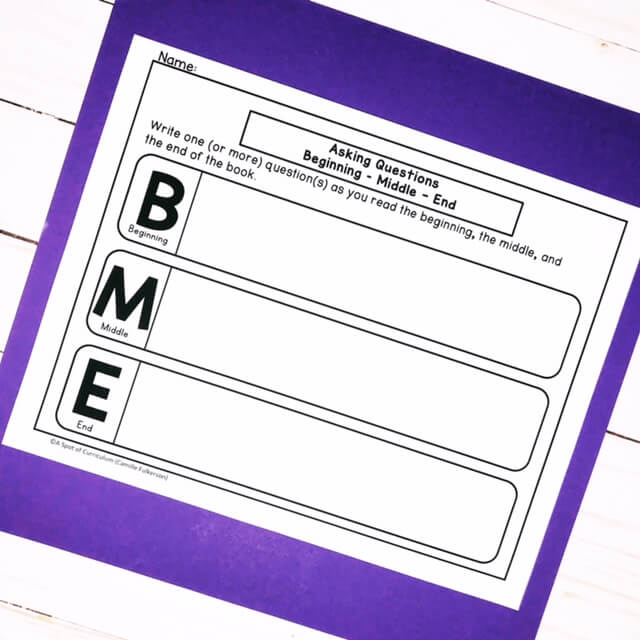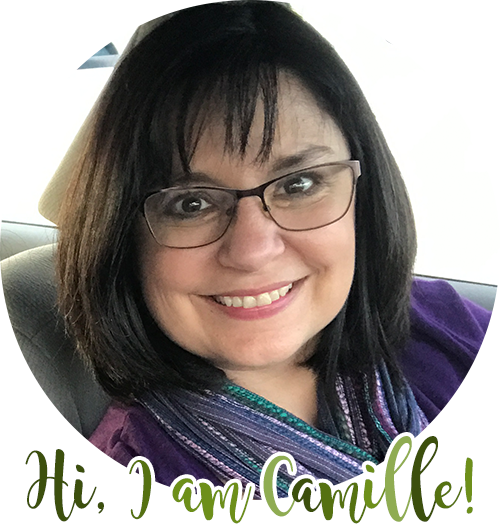Using these engaging ideas for teaching questioning is so much fun. This reading comprehension strategy can be lots of fun to teach. There are tons of great picture books that lend themselves to teaching questioning. When you teach a strategy to students you need to revisit it often. In order for students to understand how and when to use a strategy, you have to model it often. You can teach a strategy a few times and students will even understand and be able to use it. But unless you show them often how you use it, they will never add it to their reading repertoire. Here are some engaging ways to teach and practice the questioning strategy.

Questioning Cards
One of my favorite ways to practice questioning is to pass out Question Cards. These are slips of paper or index cards with a question mark on them. You can pass out one or more Question Cards to each student. As you are reading aloud, students have to write one question on each card that they have. This is powerful because it forces students to think and formulate a question. After that, you can have the students pair up and read their questions to each other. Students work together to see if the question was answered in the text or if it was not. This can lead to great discussions. The Question Cards can also be used during independent reading or partner reading to practice asking and answering questions.
Question Word Tally
A similar way I promote the asking of questions is by teaching question words. I normally have the question words on a chart to help support the students in asking questions. They seems to ask more questions when they have the questions words or stems to get them started.
Often in order to make sure we are asking a variety of questions, I will have a student stand my the poster and keep tally marks of how many times the question words or questions stems were used. Not only does this promote the asking of questions, but it helps students to ask a variety of questions. This can be done with students asking the questions out loud or they jot the questions down. If I opt for the jot down, we stop every so often to ask the questions and to keep track of the question words or stems used. Then we read the second part of the book and try to ask questions using words or stems that were not used as much.
Questions in the Margin
I love to show students books that I have read, where I have marked up the text. I show highlighting, underlined words, and yes questions that I have written in the margins. Of course, we talk about that I only write in books that I have purchased and love. Next I love to demonstrate by doing a shared reading. I use a printed article and together we asked questions that I jot in the margin. Then we use a highlighter when we find the answer to a question in the text. Finally I like to give them another article to practice writing questions and highlighting answers to the questions.
My 3 Favorite Questions
When students are practicing questioning, it really helps to read off a few of the best questions that the students have generated. I try to pick at least one question that is a general question like many of the students write. When picking this question, I try to pick the most unique of these general questions. Sometimes students focus on an unusual detail that other students might have missed. The other two questions that I pick are the best overall questions that are deeper than most of the other questions written.
The first question is to differentiate for students who are not ready to write deeper questions but can improve the questions they are writing. The last two questions are to show all students how deep their questions can become. This really helps all your students begin to ask deeper questions.
Question Poster
To help your students become more inquisitive in all subject areas, it will help to have a place where they can ask questions on a regular basis. A Question Poster is a great way to do this. The students can ask any school appropriate question and put it on the poster. The students can write their questions directly on the poster or you can have them put questions on a sticky note to hang on it. The teacher needs to read a few questions and help the students answer them every few days or once a week. The challenge with anything extra in the classroom is making time for it and getting students to use it regularly. Here are a couple of suggestions to help incorporate this routine.
- Make time for it in your schedule and stick to it. The students pay attention to whatever the teacher pays attention to. If you read or discuss questions on a regular basis, they will be more apt to ask questions and put them on the poster.
- Students sometimes forget to put their questions on the poster. As a teacher, you have to redirect oral questions and ask them to write them down. If a student asks an unrelated question or if the students are getting a little off-topic, it is great to have them put it on the Question Poster.
- Offer the question poster as a reading option during self-selected reading. If a student knows an answer to a question or wants to research an answer, they can write a response.
Graphic Organizers
A great engaging idea for teaching questioning is to encourage students to write questions is by using a graphic organizer. These organizers are a great way to get students to practice using reading strategies. They help to organize the thinking of students. Here is a Free Questioning Graphic Organizer for you to use with your students.

Question Words
In addition, another engaging idea for teaching questioning is having a question word or stem poster, I like to challenge students to use certain question words. I typically have question words or stems written on cards that I pass out to the students. You can give each student one or two cards to use to write their questions. Students will sometimes only use one or two question words and this activity helps students to broaden their ability to write different types of questions
Question Continuum
After students have had lots of practice asking questions, it is time for them to see that there are different kinds of questions. One way to do this is to put questions on a continuum from simple to complex. One way to talk about this is to use the terms thin and thick questions. I learned to use these terms from the book Strategies That Work by Stephanie Harvey and Anne Goudvis. Learn more about this book here. Thick questions are the more complex questions and thin are the smaller clarifying questions.
One way to teach students about this is to put the questions on a continuum. This is a more difficult skills so it is good to model this process with questions that you have written about a book you are reading. You can put a few questions on the continuum to model and then have the students help you place the last several of them. In a later lesson, the students will place the questions they have written on a continuum. I would do this in a large group first and then they can move to smaller groups.
Getting Ready to Teach Questioning
These ideas are so much fun to add to your classroom. If you want to save time in preparing to implement the ideas in this article check out Asking Questions Activities for Reading Comprehension.
Your students will learn so much from these engaging ideas for teaching questioning. With lots of modeling and practice, your students will begin to use questioning as a strategy to make themselves think about the text. And when students think about the text, they then begin to comprehend at really deep levels.

This site contains affiliate links. This simply means if you buy something using our link, we will receive a very small portion of the sales. The price of the item is the same whether it is an affiliate link or not. It is our promise to you that we only recommend products or services we believe will add value to our readers. By using the affiliate links, you are helping support our Website, and we genuinely appreciate your support.

